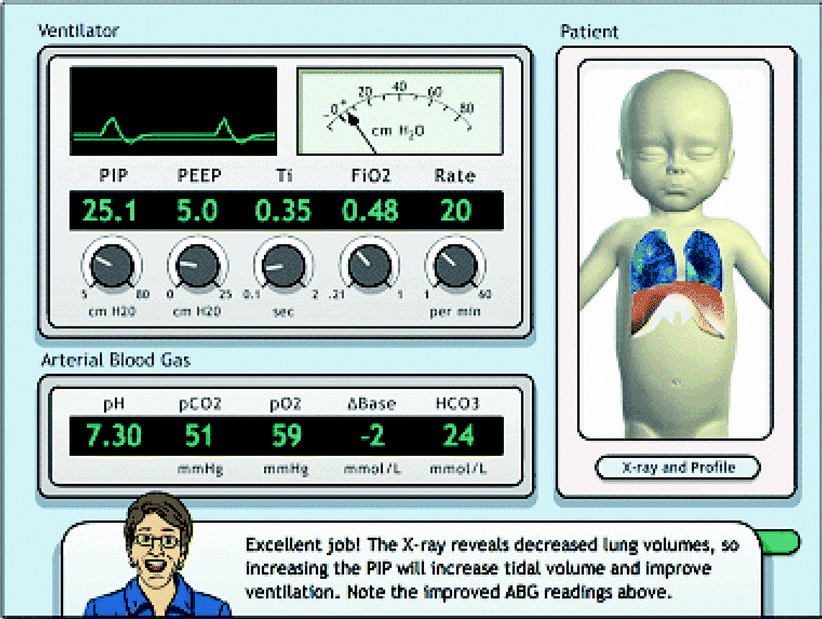Fig. 14.1
A screen-based simulator for general anesthesia training, ca. 1987. The simulator’s mouse-controlled graphics display is shown, depicting a patient, the patient history, and key aspects of the operating room environment (From Schwid [7])
The Fidelity Spectrum in Screen-Based Simulation
Screen-based simulators for health-care education now encompass a broad spectrum of fidelity, a term that describes the number and authenticity of sensory or environmental “cues” that the simulator provides as part of the context surrounding the clinical scenario it depicts. Occupying the highest end of the environmental and psychological fidelity spectrum are “virtual reality” trainers. These are highly sophisticated screen-based simulators that are capable of representing complex physical spaces in three dimensions while allowing multiple users to interact with virtual objects and animated versions of one another (“avatars”) within the virtual environment [8]. Positioned somewhat lower on the fidelity spectrum are “conventional” screen-based simulators, which aspire to represent fewer aspects of the physical environment, yet demonstrate a degree of fidelity sufficient to refine clinical judgment and develop the cognitive structures that are required to execute complex tasks in a reliable manner.
All screen-based simulators, regardless of their fidelity level, address some of the inherent disadvantages of mannequin simulation. First, because screen-based simulations are entirely conducted on a personal computer or within a web browser, they offer unparalleled flexibility of the time and place in which the training exercises occur. Second, every correct or incorrect decision the operator makes during the simulation can be captured and tracked quite easily, rendering screen-based simulation highly suitable for developing or assessing competency in large groups of health-care providers. In the case of virtual reality simulators, even physical movements can be captured and tracked, a feature which renders them capable of driving trainees to higher levels of technical skill performance. Finally, screen-based simulations offer significant cost advantages over mannequin simulation [9]. While screen-based simulations can have high initial development costs, they do not require an instructor to be present while the trainee completes an exercise.
While virtual reality simulators possess a set of attributes that will ultimately allow instructors to extend screen-based simulation objectives beyond the cognitive domain into the technical and affective domains, fulfillment of their potential to truly transform simulation training remains dependent on additional research and development. This chapter will focus on conventional screen-based simulation, an area in which there has been considerable growth over the past several years.
Core Technical Standards for Screen-Based Simulators
There are several key attributes possessed by all screen-based simulators that allow them to operate “intelligently” and provide an effective learning experience without the need for instructor presence (Table 14.1). First, screen-based simulators have a graphical user interface that displays the simulator “output.” The display includes an image of the patient that changes according to how the simulated scenario unfolds and shows monitored clinical parameters that are appropriate for the type of setting in which the scenario is supposed to be occurring. For example, scenarios that are occurring in an emergency department or hospital ward setting should at least show an ECG tracing sweeping across the cardiac rhythm monitor, and perhaps an oxygen saturation tracing. Scenarios that are occurring in the operating room or an intensive care setting should add dynamic waveform displays for arterial blood pressure, central venous pressure, and end-tidal carbon dioxide, as well as pulmonary arterial catheter waveforms, if applicable. Audible alarms and/or monitor tones can provide realistic environmental cues that deepen the operator’s engagement with the simulation. The graphical user interface should operate as intuitively as possible, so that the trainee can provide “input” to the simulator using a computer mouse, touchpad, or simple keyboard controls, as appropriate for the device on which the program is operating. The key to ensuring interface simplicity is to maintain a very clear idea of the training objectives and limit the “scene detail” portrayed in the displays to only those elements that are required to manage the case. Although initial development of an elegant user interface involves considerable effort and expense, individual components such as cardiac rhythm displays, patient images depicting various stages of resuscitation, the defibrillator, and a representation of other medical devices can be reused as part of any number of scenarios, thus reducing the overall development costs [8].
Table 14.1
Key attributes of screen-based simulators
Easy-to-use graphical user interface |
Models and states to predict simulated patient responses |
Automated help system |
Automated debriefing and scoring |
Automated case record |
Case library |
Learning management system compatibility |
Screen-based simulators must be developed around a simulation “engine” that governs how the simulated patient responds to the operator’s interventions during the case. The engine consists of mathematical models of pharmacology as well as cardiovascular and respiratory physiology. The pharmacokinetic model predicts blood and tissue levels as well as elimination for any drug administered to the simulated patient. The pharmacodynamic model predicts the effects of any drug on heart rate, cardiac contractility, vascular resistance, baroreceptor response, respiratory drive, and other physiologic parameters. The cardiovascular model predicts changes in cardiac output and blood pressure in response to these effects, and the respiratory model predicts subsequent alterations in gas exchange which are reflected in the simulated patient’s blood gas. Thus, the individual models interact with one another to emulate and portray complex human pathophysiology. What appears to the operator as a dynamic yet coherent case scenario is actually modeled using a finite number of states. The case author designs a set of states, each of which describes the physiologic condition of the patient at various points as the simulation unfolds. Each state moves to the next if a set of predetermined transition conditions are met. The physiologic status of the simulated patient, as represented in the simulator as vital sign changes, laboratory values, and other cues, is constantly updated by the combination of model predictions and transitions between states. Discussion of how a finite state machine interacts dynamically with mathematical models to depict a realistic clinical scenario is available in Schwid and O’Donnell’s 1992 description of a malignant hyperthermia simulator [10].
Screen-based simulators should also contain a series of embedded feedback devices to provide guidance to the trainee as he or she navigates the case scenario. These include an automated help system which provides real-time information about drug dosing and mechanism of action, as well as on-demand suggestions for the trainee about what he or she should do next for the patient [11]. In addition, these simulators should contain an automated debriefing system that captures all of the management decisions that were made during the case [12]. This system recognizes when the operator has met all the learning objectives for the scenario and issues feedback that the simulation has ended. However, if the patient does not survive in the scenario, the debriefing system issues feedback suggesting the operator practice the case again. In either situation, when the scenario is over, the debriefing system provides a time-stamped record of decisions the operator made while managing the case. In addition, the case record produces a complete log of the user’s management decisions and patient responses [13]. It also indicates where the user gained or lost points during the scenario and issues a score for overall performance.
Ideally, the simulator software package would include a set of pre-written, ready-to-use case scenarios, or a case library [14, 15]. Each simulation case scenario in the library is represented by a data file that is read and interpreted by the simulator program. There are many possible formats for the data file including simple text or XML (extended markup language) [16, 17]. It is desirable for case authors to share their case scenarios with one another in order to facilitate development of a large library of content. At this time, there is no single standard case format, but the Association of American Medical Colleges supports a web-based, accessible format at its medical education content repository, MedEdPORTAL (https://www.mededportal.org/). See, for example, a case scenario for anaphylaxis which comes complete with learning objectives and debriefing messages [18].
In recent years, many health-care organizations have adopted ways to centralize and automate the administration of training modules to their clinician workforce. These “learning management systems” (LMS) are software applications capable of importing and managing a variety of e-learning materials, provided the learning modules comply with the system’s specifications for sharable content (e.g., Sharable Content Object Reference Model or “SCORM”). LMS compatibility is rapidly becoming a desirable attribute for screen-based simulators, as they progress from operating as installed applications on individual computer terminals to applications that can operate within web browsers. Integrating screen-based simulation into a learning management system gives administrators the ability to chart health-care professionals’ progress through a diverse library of training cases. As standardized scoring rubrics for screen-based simulations are developed and validated, learning management systems will also be able to securely track specific competencies, as assessed using screen-based simulation rather than traditional multiple-choice testing.
Examples of Screen-Based Simulators
Several software companies now market case-based simulations that are designed to operate on personal computers. Mad Scientist Corporation (www.madsci.com) and Anesoft Corporation (www.anesoft.com) have each been in this business for approximately 25 years. Both produce a suite of programs that offer training in the management of adult and pediatric acute and critical care scenarios. Anesoft Corporation has a particularly extensive range of case-based simulators encompassing the domains of adult and pediatric critical care, neonatology, obstetrics, anesthesiology, and bioterrorism (Table 14.2). This chapter will focus its discussion on Anesoft screen-based simulators and a couple of other innovative and promising research prototypes.
Table 14.2
Anesoft case-based medical simulators
ACLS Simulator |
PALS Simulator |
Anesthesia Simulator |
Critical Care Simulator |
Sedation Simulator |
Pediatrics Simulator |
Obstetrics Simulator |
Neonatal Resuscitation Simulator |
Bioterrorism Simulator |
Hemodynamics Simulator |
Anesoft Advanced Cardiac Life Support (ACLS) Simulator
The Anesoft ACLS Simulator was developed almost 20 years ago, to address the observation that knowledge of the American Heart Association guidelines for management of cardiac arrest states decayed quickly following formal classroom training [19–22]. The program was originally designed as an installed application that could run on Windows (Microsoft Corporation, Redmond WA) computers [23]. Two modules are contained within the ACLS Simulator package. The “Rhythm Simulator” is designed to teach and reinforce a structured approach to recognizing common cardiac rhythm disturbances. The second module is the ACLS megacode simulator itself, whose graphical user interface displays dynamic photographic images of the simulated patient and two resuscitators, as well as a cardiac monitor displaying the patient’s current rhythm sweeping across the screen (Fig. 14.2). The user controls the actions of the resuscitators by interacting with the interface using a computer mouse and a series of dashboard buttons. The ACLS Simulator contains an automated debriefing system and a built-in, on-demand help system that prompts the user to take the next appropriate action in each scenario. At the conclusion of each case, the simulator produces a detailed, downloadable or printable case record summarizing all of the decisions the trainee made during the scenario and assigns a score for overall performance. The ACLS Simulator 2011 assesses user performance according to the American Heart Association’s 2010 Guidelines for Cardiopulmonary Resuscitation and Emergency Cardiovascular Care [24]. ACLS Simulator 2011 operates on Windows and Macintosh computers in almost any browser. The simulator contains a case library consisting of 16 cases covering ACLS guidelines for the management of ventricular fibrillation/pulseless ventricular tachycardia, ventricular tachycardia with pulse, pulseless electrical activity, and assorted other tachycardic and bradycardic dysrhythmias. Completion of ACLS Simulator 2011 cases is not sufficient for provider credentialing through the American Heart Association but does entitle the user to as many as 8 American Medical Association Physician Recognition Award Category 2 Continuing Medical Education credits. A couple of key distinctions between ACLS 2011 and earlier versions of the simulator are that it operates completely within any web browser and it meets SCORM and Aviation Industry Computer-Based Training Committee (“AICC”) standards, which means that the simulator is now compatible with many institutional learning management systems. Most recently, the ACLS Simulator 2011 has been modified so that it can port to mobile devices. The more streamlined “iPhone and iPad” (Apple Corporation, Cupertino CA) and “Android” (Google, Menlo Park CA) versions of the simulator contain the same drug library as the parent version, but contain only 12 cases. While the mobile version allows defibrillation, it does not allow transcutaneous pacing, IV fluid management, lab values, caselog downloading/printing, or CME credits (Fig. 14.3). The “Rhythm Simulator” is not included as part of the mobile ACLS Simulator package but is available separately.
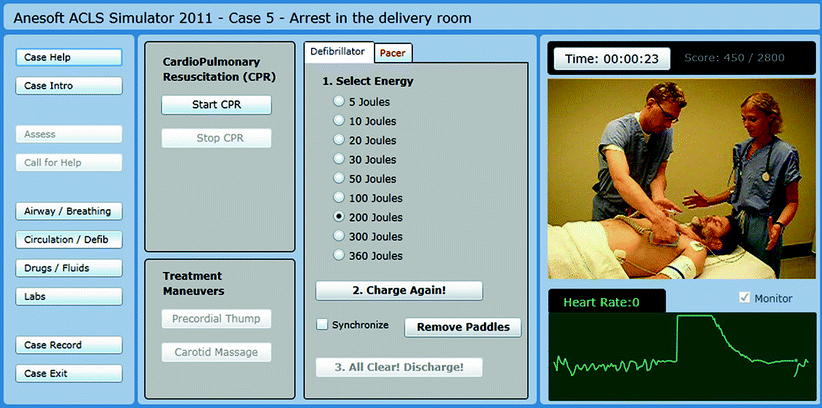
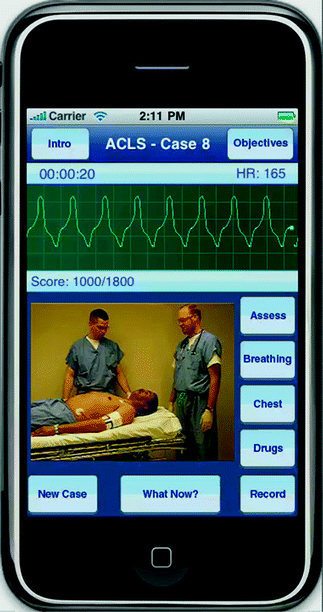

Fig. 14.2
Graphical user interface for the Anesoft ACLS Simulator 2011. Dynamic photographic images show the patient, 2 resuscitators, and the actions the user commands them to perform by using a mouse or touchpad to interact with the interface buttons. Note the dynamic cardiac rhythm waveform in the lower right of the figure, which depicts the upward voltage deflection (and subsequent voltage decay) associated with the countershock. Note: In the Anesoft Simulators, the patient and the resuscitators shown in the photographic images are portrayed by actors

Fig. 14.3
Anesoft ACLS 2011, “iPhone and iPad” version. As compared to the full-scale ACLS Simulator 2011, this user interface is simplified but still shows dynamic photographic images of the patient and resuscitators and shows a dynamic cardiac rhythm waveform. Elapsed scenario time (upper left) and the running score tally are also displayed
Laerdal HeartCode® ACLS Simulator
HeartCode® ACLS (Laerdal Corporation, Stavanger, Norway) has many similarities to the Anesoft ACLS Simulator. It is also a web-based program that enables students to diagnose and treat a number of Advanced Cardiac Life Support scenarios [25]. The package has a total of ten cases with one BLS case, two megacode scenarios, and seven other emergencies. The program includes on-line help (coaching) and automated debriefing. Unlike with the Anesoft ACLS Simulator, the electrocardiogram in HeartCode® ACLS is a static image rather than a dynamic, sweeping waveform.
Anesoft Pediatric Advanced Life Support (PALS) Simulator
The Anesoft PALS Simulator was created in the mold of its adult (ACLS) counterpart in 2006 [26]. The original version was configured to operate on any Windows-compatible computer and was designed to provide robust training in the key cognitive aspects of conducting an advanced pediatric resuscitation in accordance with published guidelines [27]. As in the ACLS Simulator, the graphical user interface displays dynamic images of the patient, the resuscitators, and a cardiac rhythm monitor, and the operator directs the resuscitators to perform various interventions using a series of buttons and a mouse-controlled menu (Fig. 14.4a). The PALS Simulator also contains an automated debriefing system and on-demand help system, and the simulator’s drug information library provides dosing guidelines appropriate for pediatric patients.


Fig. 14.4
(a) Graphical user interface for the Anesoft PALS Simulator 2006. Dynamic photographic images of the patient and 2 resuscitators are shown. The resuscitators execute tasks as commanded by the user using a mouse or touchpad to interact with the interface buttons. A dynamic cardiac rhythm waveform sweeps across the bottom of the screen as shown. (b) Anesoft PALS Simulator 2011 graphical user interface. Dynamic photographic images depict the patient, the resuscitators, and the actions the user commands the resuscitators to perform. A dynamic cardiac rhythm waveform sweeps across the “monitor screen” at lower right; artifact from chest compressions is superimposed over the underlying rhythm
In 2011, the Anesoft PALS Simulator was modified to operate completely within a web browser [26]. PALS Simulator 2011 assesses user performance according to the American Heart Association’s 2010 Guidelines for Cardiopulmonary Resuscitation and Emergency Cardiovascular Care [27]. It also features improvements to the user interface (Fig. 14.4b) and other modifications that were suggested in a survey of multidisciplinary pediatric health-care professionals who provided feedback on the original version of the PALS Simulator [28]. The simulator’s original library of 12 cases was extended to 16 cases for the 2011 version, in response to user feedback. In addition to the original 12 cases representing the 4 major PALS treatment algorithms (supraventricular tachycardia, pulseless electrical activity, ventricular fibrillation/pulseless ventricular tachycardia, and bradycardia), PALS Simulator 2011 now includes 4 Pediatric Emergency Assessment, Recognition, and Stabilization (“PEARS”) cases that emphasize averting cardiac or respiratory arrest through prompt reversal of shock or other forms of cardiopulmonary distress [29]. PALS Simulator 2011 also contains a basic case scenario that serves as a structured tutorial on how the simulator operates. Users who complete cases on PALS Simulator 2011 do not automatically receive provider credentialing through the American Heart Association but are entitled to as many as 8 American Medical Association Physician Recognition Award Category 2 Continuing Medical Education credits. PALS Simulator 2011 is also SCORM and AICC compliant. PALS Simulator for iPhone, iPad, and Android devices is under development.
Anesoft Anesthesia and Critical Care Simulators
The Anesoft Anesthesia Simulator has undergone a series of technical improvements and iterative upgrades since it was first introduced more than 20 years ago [13]. The current version is able to operate as an installed application on any Windows computer. The user interface displays an image of the patient, dynamic waveforms for monitored physiologic parameters, audible monitor tones, a representation of the anesthesia machine and spirometer, and a status report on the surgeon’s activities during the case (Fig. 14.5). The simulator contains an on-demand help system, an automated debriefing system, and a drug library containing over 100 medications. Mathematical models of pharmacokinetic, pharmacodynamic, cardiovascular, and respiratory interactions predict the simulated patient’s response to medications and are capable of representing both normal patients and patients with underlying acute or chronic illness. The simulator contains a library of 34 cases representing a range of anesthesia emergencies as well as scenarios spanning a clinical spectrum from regional anesthesia to specialty-specific domains such as cardiovascular, obstetric, pediatric, and neurosurgical anesthesia. The Anesoft Anesthesia Simulator is used in more than 50 countries worldwide and has been translated into Spanish and Portuguese [30].
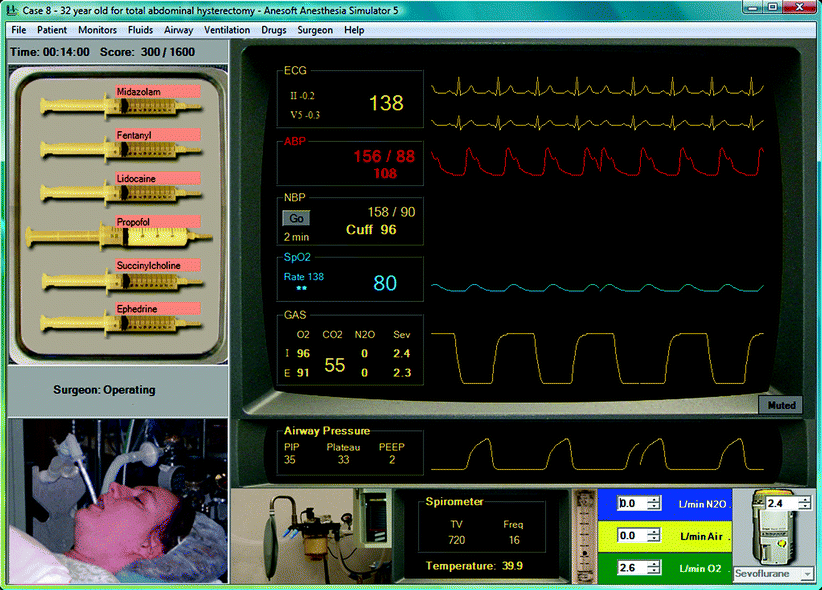

Fig. 14.5
User interface for the Anesoft Anesthesia Simulator. Dynamic cardiac rhythm, hemodynamic, and respiratory waveforms sweep across the monitor screen. An image of the patient is depicted at lower left. The surgeon’s activities are represented as supplementary text above the patient image
The original version of Anesoft’s Sedation Simulator was created more than a decade ago, as the product of a collaborative research project between the Department of Radiology at Cincinnati Children’s Hospital Medical Center, the Department of Anesthesiology at the University of Washington, and Anesoft Corporation [31]. The project’s objectives were to develop an interactive screen-based simulator that could train radiologists in the management of analgesia during painful procedures and in responding to critical incidents such as complications following contrast media administration. The Sedation Simulator has since undergone a series of upgrades and improvements, owing partly to additional contributions from content experts representing gastroenterology and dental surgery. The current version of the simulator operates as an installed application on any Windows computer and contains a library of 32 adult and pediatric case scenarios representing a range of circumstances such as anaphylaxis, agitation, aspiration, apnea, bradycardia, hypotension, and myocardial ischemia. The user interface displays images of the patient as well as dynamic waveforms reflecting desired monitored parameters such as a cardiac rhythm tracing, peripheral oxygen saturation, and end-tidal capnography. Noninvasive blood pressure readings are also displayed. Comments and questions from the “proceduralist” are provided for the sedation provider (i.e., the simulator user) in the form of status updates that are displayed on the screen.
Anesoft’s (adult) Critical Care Simulator possesses many of the attributes of the Anesthesia Simulator but is designed to portray clinical scenarios that take place in an emergency department or intensive care unit setting [32]. Accordingly, the user interface displays only those parameters that are routinely monitored in either of those environments. The Critical Care Simulator operates on Windows computers and contains a library of six case scenarios. Anesoft’s Pediatrics Simulator is analogous to the Critical Care Simulator. Its user interface displays images of pediatric patients and its case library contains six scenarios representing complex acute and critical illness states [33].
The Anesoft Obstetrics Simulator was developed to train clinicians in the management of obstetric emergency scenarios [34]. The simulator operates on Windows computers, and its user interface displays images of the patient and all dynamic waveforms representing typical monitored parameters including an electrocardiogram tracing, blood pressure, peripheral oxygen saturation, and patient temperature. In addition, uterine tone and a fetal heart tracing are displayed (Fig. 14.6). The case library contains eight scenarios covering a range of obstetric emergencies such as placental abruption, postpartum hemorrhage, ectopic pregnancy, trauma, and cardiac arrest.
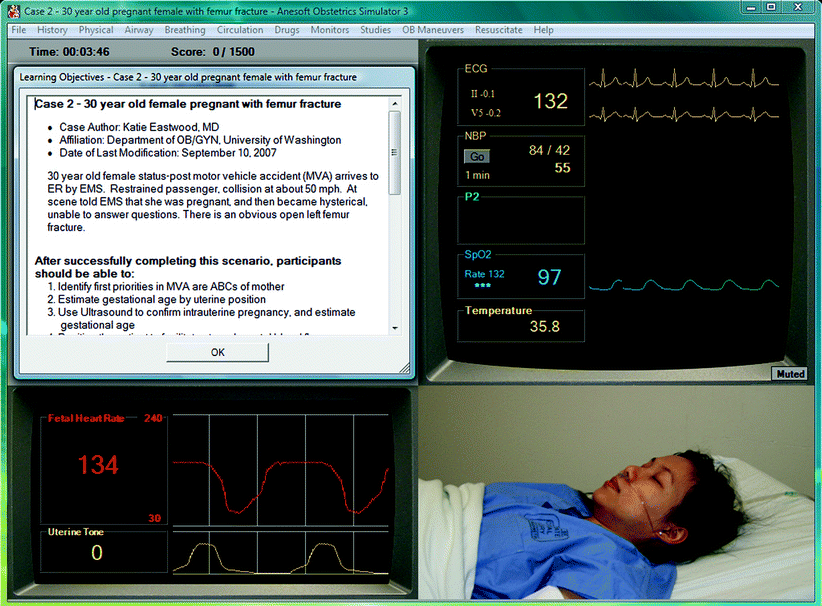

Fig. 14.6
User interface for the Anesoft Obstetrics Simulator. Dynamic cardiac rhythm and respiratory waveforms sweep across the monitor at upper right. Dynamic fetal heart and uterine tone tracings sweep across the monitor at lower left. An image of the patient is shown at lower right
The Anesoft Neonatal Simulator also works on Windows computers and is designed to train clinicians in the management of important delivery room emergencies [35]. The user interface displays images of the neonate and any interventions the resuscitators are performing. Monitored physiologic parameters that are displayed on the interface include the infant’s cardiac rhythm and peripheral oxygen saturation tracing. The case library contains 12 scenarios, including fetal heart rate decelerations, severe fetal bradycardia, meconium-stained amniotic fluid, and meconium aspiration.
The Bioterrorism Simulator is the final example in this summary of Anesoft’s portfolio of interactive case-based simulators. The Bioterrorism Simulator was developed in 2002 as a multilateral collaboration involving the Anesoft Corporation, experts from the military, and content experts from the specialties of infectious diseases, public health, critical care, and toxicology [36]. It works in both Windows and Macintosh browsers, and its objective is to train first responders to recognize, diagnose, and treat patients who demonstrate signs and symptoms of possible exposure to biological or chemical agents, while avoiding personal contamination. The user interface displays an image of the patient and dynamic waveform displays of all monitored physiologic parameters. An on-demand help system provides real-time assistance with appropriate case management. The case library contains 24 scenarios reflecting a range of clinical presentations from what content experts believe to be the most likely terrorist threats: anthrax, botulism, ebola virus, plague, tularemia, smallpox, and nerve agent or vesicant exposures. At the conclusion of each scenario, the automated debriefing system produces a detailed record of correct and incorrect decisions made during the case.
New Horizons: The “Virtual NICU,” Transparent Reality, and Multiuser Simulation
The unique throughput advantages of screen-based simulation have been incorporated into a national strategy to reengineer neonatal nurse practitioner (NNP) training, in order to better meet the growing demand for a skilled NNP workforce [37]. The “Neonatal Curriculum Consortium” is a group of experienced NNPs whose overall vision is to develop robust, standardized, interactive training modules and host them on an Internet site that is scheduled to be completed in 2012. Interactive training incorporating regular use of these modules would then be integrated into existing NNP training curricula across the United States. In collaboration with the Institute for Interactive Arts and Engineering at the University of Texas at Dallas, the Neonatal Curriculum Consortium has developed an innovative, case-based, web-enabled simulator called the “Interactive Virtual Ventilator” (Fig. 14.7). The user interface displays a representation of a patient, a chest x-ray, blood gas data, and a representation of a ventilator, an airway pressure gauge, and a ventilator waveform. The ventilator console contains inspiratory and expiratory pressure controls, as well as inspiratory time, FiO2, and ventilator rate controls that the learner can manipulate in order to produce changes in blood gas values. There is a built-in help system in the form of a pop-up avatar of a “coach” who provides feedback on whether the trainee made appropriate or inappropriate ventilator adjustments and offers a brief commentary explaining the rationale for the correct answer. Graduate NNP students at the University of Texas at Arlington pilot tested the Interactive Virtual Ventilator in 2010, and their feedback will be incorporated into future simulator modifications and improvements [38].

